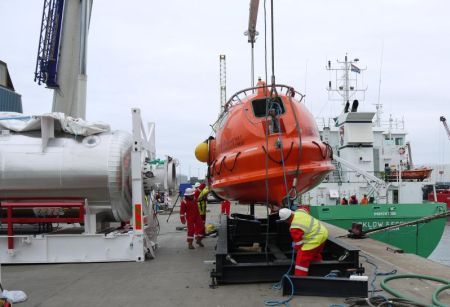
Aberdeen-based subsea installation contractor Bibby Offshore is leading the way in saturation diving safety in the North Sea after recently carrying out fully successful evacuation trials.
The trials involved mating a Self Propelled Hyperbaric Lifeboat (SPHL) from the company’s Diving Support Vessel (DSV), Bibby Sapphire, to a Portable Hyperbaric Reception Facility onshore.
Saturation diving requires divers to live in a confined area on the vessel that has a controlled atmosphere. This allows them to work at depths of up to 300 meters below sea level. However, it can take up to seven days for the divers to decompress to normal atmospheric conditions. In the case of an emergency, such as a fire or sinking ship, the divers need to be transferred to the SPHL, which would then be launched from the ship and sailed to safety, awaiting rescue.
The Portable Hyperbaric Reception Facility, built by Mimir Marine, is a shore based point that allows saturation divers to be transferred from a SPHL to a more comfortable living area, pre-set at the correct atmospheric level, where they can continue to decompress safely. It also allows a medic or doctor to be in situ, capable of treating any divers that may require further medical attention.
Barry Porter, Bibby Offshore, global diving operations manager, said: “Bibby Offshore is determined to ensure that we have the best possible facilities for dealing with any diving emergencies. The success of the trial clearly shows our commitment to ensuring that, not only are we investing in state of the art equipment, but more importantly, document the processes and procedures we would follow in an emergency as proven.”
The trials have been commended by diving authorities from two major global oil and gas operators.
Derek Beddows, BP global diving technical authority, was invited by Bibby to the trials. He said: “It is very encouraging to see Bibby Offshore now moving forward positively with this very important safety initiative that would be essential to the preservation of life in the event that divers ever had to be evacuated from saturation on a vessel in distress.”
“It is also very satisfying to note that BP’s own Policy Statement 002,‘Effective Hyperbaric Evacuation, SPHL Transit and Diver Reception Facilities’, is now being widely recognised and complied with across the Industry after little more than a year since its release.
“Going forward, I remain positive that all of our North Sea and Global Saturation Diving Contractors shall also consider the benefits of such trials between their own SPHL’s and selected Hyperbaric Reception Facilities which shall provide us with the confidence that in the event of a hyperbaric emergency, the systems and facilities will both be in place and proven to be capable of giving the evacuated divers the very best chance of survival”
Noor Roody, head of underwater operations for Total, also attended the trials and was equally impressed. “Total fully supports any advance or innovation that improves diver safety and see this as a step change in hyperbaric emergency reception.”
Bibby Offshore, part of the Bibby Line Group, has grown from 10 employees in 2003 to now employing over 600 people worldwide, with offices in Aberdeen, Singapore and Trinidad.
The company has an international fleet of five subsea support vessels including the most modern fleet of DSV’s in the North Sea. In 2011, the company launched Bibby Remote Intervention Limited (BRIL) a dedicated Remote Operated Vehicle (ROV) company supplying ROV support to the company’s own vessels and also diverless intervention services to others.
We use cookies to improve your experience. By continuing to use our site, you accept our Cookies, Privacy Policy,Terms and Conditions. Close X